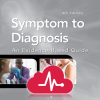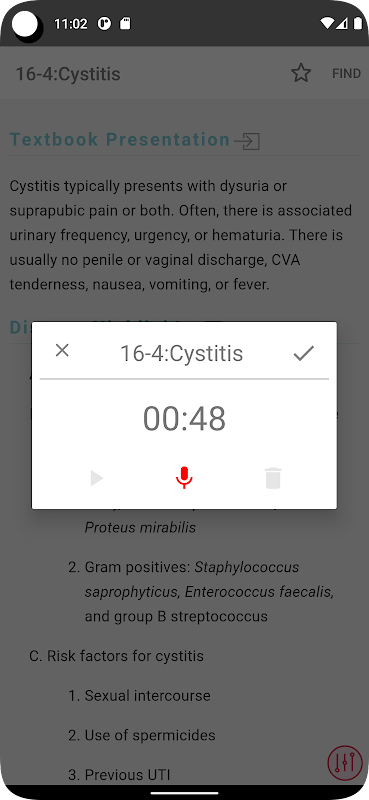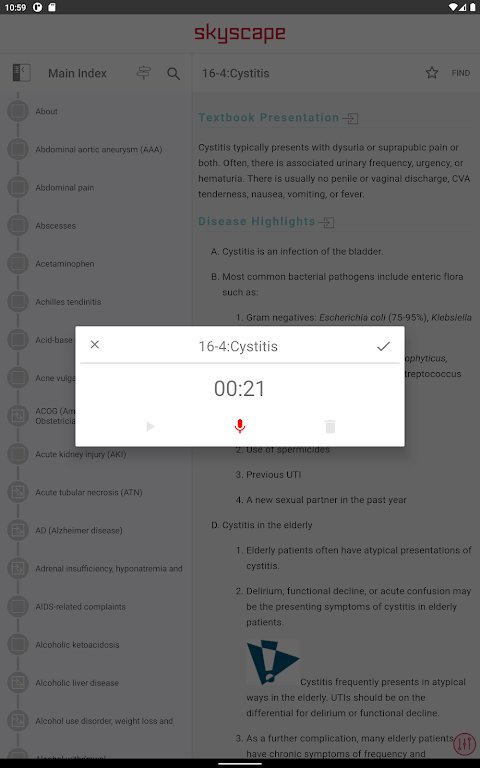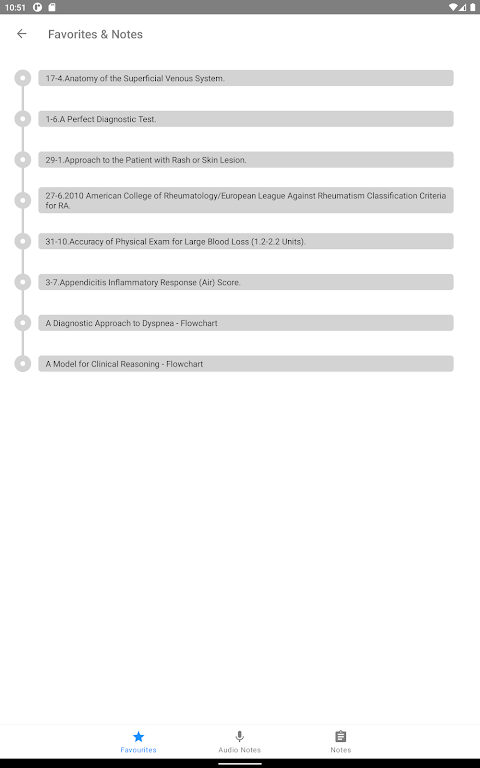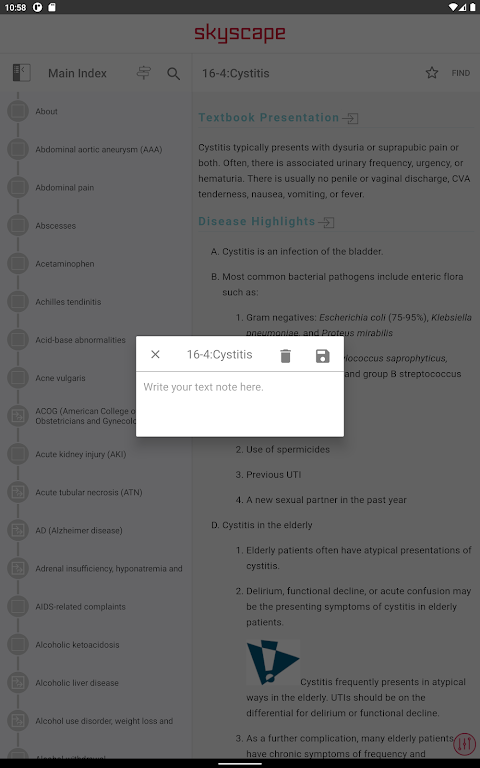"Try before you buy" - Download the FREE App, which includes sample content. In-App purchase required to unlock all content.
Symptom to Diagnosis aims to help students and residents learn internal medicine and focuses on the challenging task of diagnosis. Learn the diagnostic process in internal medicine with this engaging, case-based approach.
DESCRIPTION
"This book is a tremendous asset for students and residents learning to develop their diagnostic skills. It can also be useful as a refresher for established clinicians when the more common diagnoses are not the cause of a patient's complaints."―Doody's Review
An engaging case-based approach to learning the diagnostic process in internal medicine
Doody's Core Titles for 2021!
Symptom to Diagnosis, the latest edition teaches an evidence-based, step-by-step process for evaluating, diagnosing, and treating patients based on their clinical complaints. By applying this process clinicians will be able to recognize specific diseases and prescribe the most effective therapy.
Each chapter is built around a common patient complaint that illustrates essential concepts and provides insight into the process by which the differential diagnosis is identified. As the case progresses, clinical reasoning is explained in detail. The differential diagnosis for that particular case is summarized in tables that highlight the clinical clues and important tests for the leading diagnostic hypothesis and alternative diagnostic hypotheses. As the chapter progresses, the pertinent diseases are reviewed. Just as in real life, the case unfolds in a stepwise fashion as tests are performed and diagnoses are confirmed or refuted.
Completely updated to reflect the latest research in clinical medicine, this fourth edition is enhanced by algorithms, summary tables, questions that direct evaluation, and an examination of recently developed diagnostic tools and guidelines. Clinical pearls are featured in every chapter. Coverage for each disease includes: Textbook Presentation, Disease Highlights, Evidence-Based Diagnosis, and Treatment.
Changes include new algorithms and approaches in the chapters on Chest Pain, Syncope, Dizziness, and others. Recently developed new diagnostic tools are discussed in the chapters of Diarrhea, Jaundice, and Cough and Fever, and new guidelines have been included in the chapters on Screening, Diabetes, and Hypertension
Content licensed from printed edition ISBN 10: 1260121119
Content licensed from printed edition ISBN 13: 978-1260121117
SUBSCRIPTION :
Please choose an auto renewable subscription plan to receive content access and continuous updates. Your subscription automatically renews as per your plan, so you always have the latest content.
Six months auto-renewing payments - $29.99
Yearly auto-renewing payments- $49.99
Payment will be charged to your Google Play Account at confirmation of purchase. Initial purchase includes a 1-year subscription with regular content updates. Your subscription will automatically renews unless auto-renew is turned off at least 24-hours before the end of the current period. If you do not choose to renew, you can continue to use the product but will not receive content updates. Subscription may be managed by the user and auto-renewal can be disabled at any time by going to Google Play Store. Tap Menu Subscriptions, then select the subscription you want to modify. Follow the instructions on the screen to pause, cancel or change your subscription. Any unused portion of a free trial period will be forfeited when you purchase a subscription, where applicable.
If you have any questions or comments, email us any time: [email protected] or call 508-299-3000
Privacy Policy - https://www.skyscape.com/terms-of-service/privacypolicy.aspx
Terms and Conditions - https://www.skyscape.com/terms-of-service/licenseagreement.aspx
Author(s): Scott D. C. Stern, Adam S. Cifu, Diane Altkorn
Publisher: The McGraw-Hill Companies, Inc.
Symptom to Diagnosis EB Guide is a comprehensive reference guide designed to assist healthcare professionals in diagnosing epidermolysis bullosa (EB), a group of rare genetic skin disorders characterized by extreme skin fragility. The guide provides a systematic approach to EB diagnosis, covering a wide range of symptoms and clinical presentations.
Classification of EB
EB is classified into four main types based on the level of the skin where blistering occurs:
* EB Simplex (EBS): Blisters form within the epidermis, the outermost layer of the skin.
* Junctional EB (JEB): Blisters form at the junction between the epidermis and the dermis, the underlying layer of the skin.
* Dystrophic EB (DEB): Blisters form within the dermis.
* Kindler EB (KEB): A rare and severe form of EB that affects both the epidermis and the dermis.
Symptoms of EB
The symptoms of EB vary depending on the type and severity of the disorder. Common symptoms include:
* Blistering: Blisters can occur spontaneously or in response to minor trauma, such as rubbing or pressure.
* Skin fragility: The skin is extremely fragile and easily damaged, even by gentle touch.
* Pain: Blisters can be painful, especially if they rupture.
* Scarring: Repeated blistering can lead to scarring and disfigurement.
* Other symptoms: EB can also affect other organs, such as the eyes, mouth, and esophagus.
Diagnosis of EB
The diagnosis of EB is based on a combination of factors, including:
* Medical history: A detailed medical history can help identify potential genetic factors or environmental triggers.
* Physical examination: A physical examination can reveal characteristic skin findings, such as blistering, scarring, or nail abnormalities.
* Family history: EB is often inherited, so a family history of the disorder can be a clue to diagnosis.
* Genetic testing: Genetic testing can confirm the diagnosis of EB and identify the specific genetic mutation responsible for the disorder.
Treatment of EB
There is no cure for EB, but treatment can help manage symptoms and improve quality of life. Treatment options include:
* Wound care: Careful wound care is essential to prevent infection and promote healing.
* Medications: Medications can help reduce pain and inflammation.
* Surgery: Surgery may be necessary to remove damaged skin or repair complications.
* Supportive care: Supportive care includes nutritional support, pain management, and emotional counseling.
Prognosis of EB
The prognosis of EB varies depending on the type and severity of the disorder. Some forms of EB are relatively mild, while others can be life-threatening. With proper care, many people with EB can live full and active lives.
"Try before you buy" - Download the FREE App, which includes sample content. In-App purchase required to unlock all content.
Symptom to Diagnosis aims to help students and residents learn internal medicine and focuses on the challenging task of diagnosis. Learn the diagnostic process in internal medicine with this engaging, case-based approach.
DESCRIPTION
"This book is a tremendous asset for students and residents learning to develop their diagnostic skills. It can also be useful as a refresher for established clinicians when the more common diagnoses are not the cause of a patient's complaints."―Doody's Review
An engaging case-based approach to learning the diagnostic process in internal medicine
Doody's Core Titles for 2021!
Symptom to Diagnosis, the latest edition teaches an evidence-based, step-by-step process for evaluating, diagnosing, and treating patients based on their clinical complaints. By applying this process clinicians will be able to recognize specific diseases and prescribe the most effective therapy.
Each chapter is built around a common patient complaint that illustrates essential concepts and provides insight into the process by which the differential diagnosis is identified. As the case progresses, clinical reasoning is explained in detail. The differential diagnosis for that particular case is summarized in tables that highlight the clinical clues and important tests for the leading diagnostic hypothesis and alternative diagnostic hypotheses. As the chapter progresses, the pertinent diseases are reviewed. Just as in real life, the case unfolds in a stepwise fashion as tests are performed and diagnoses are confirmed or refuted.
Completely updated to reflect the latest research in clinical medicine, this fourth edition is enhanced by algorithms, summary tables, questions that direct evaluation, and an examination of recently developed diagnostic tools and guidelines. Clinical pearls are featured in every chapter. Coverage for each disease includes: Textbook Presentation, Disease Highlights, Evidence-Based Diagnosis, and Treatment.
Changes include new algorithms and approaches in the chapters on Chest Pain, Syncope, Dizziness, and others. Recently developed new diagnostic tools are discussed in the chapters of Diarrhea, Jaundice, and Cough and Fever, and new guidelines have been included in the chapters on Screening, Diabetes, and Hypertension
Content licensed from printed edition ISBN 10: 1260121119
Content licensed from printed edition ISBN 13: 978-1260121117
SUBSCRIPTION :
Please choose an auto renewable subscription plan to receive content access and continuous updates. Your subscription automatically renews as per your plan, so you always have the latest content.
Six months auto-renewing payments - $29.99
Yearly auto-renewing payments- $49.99
Payment will be charged to your Google Play Account at confirmation of purchase. Initial purchase includes a 1-year subscription with regular content updates. Your subscription will automatically renews unless auto-renew is turned off at least 24-hours before the end of the current period. If you do not choose to renew, you can continue to use the product but will not receive content updates. Subscription may be managed by the user and auto-renewal can be disabled at any time by going to Google Play Store. Tap Menu Subscriptions, then select the subscription you want to modify. Follow the instructions on the screen to pause, cancel or change your subscription. Any unused portion of a free trial period will be forfeited when you purchase a subscription, where applicable.
If you have any questions or comments, email us any time: [email protected] or call 508-299-3000
Privacy Policy - https://www.skyscape.com/terms-of-service/privacypolicy.aspx
Terms and Conditions - https://www.skyscape.com/terms-of-service/licenseagreement.aspx
Author(s): Scott D. C. Stern, Adam S. Cifu, Diane Altkorn
Publisher: The McGraw-Hill Companies, Inc.
Symptom to Diagnosis EB Guide is a comprehensive reference guide designed to assist healthcare professionals in diagnosing epidermolysis bullosa (EB), a group of rare genetic skin disorders characterized by extreme skin fragility. The guide provides a systematic approach to EB diagnosis, covering a wide range of symptoms and clinical presentations.
Classification of EB
EB is classified into four main types based on the level of the skin where blistering occurs:
* EB Simplex (EBS): Blisters form within the epidermis, the outermost layer of the skin.
* Junctional EB (JEB): Blisters form at the junction between the epidermis and the dermis, the underlying layer of the skin.
* Dystrophic EB (DEB): Blisters form within the dermis.
* Kindler EB (KEB): A rare and severe form of EB that affects both the epidermis and the dermis.
Symptoms of EB
The symptoms of EB vary depending on the type and severity of the disorder. Common symptoms include:
* Blistering: Blisters can occur spontaneously or in response to minor trauma, such as rubbing or pressure.
* Skin fragility: The skin is extremely fragile and easily damaged, even by gentle touch.
* Pain: Blisters can be painful, especially if they rupture.
* Scarring: Repeated blistering can lead to scarring and disfigurement.
* Other symptoms: EB can also affect other organs, such as the eyes, mouth, and esophagus.
Diagnosis of EB
The diagnosis of EB is based on a combination of factors, including:
* Medical history: A detailed medical history can help identify potential genetic factors or environmental triggers.
* Physical examination: A physical examination can reveal characteristic skin findings, such as blistering, scarring, or nail abnormalities.
* Family history: EB is often inherited, so a family history of the disorder can be a clue to diagnosis.
* Genetic testing: Genetic testing can confirm the diagnosis of EB and identify the specific genetic mutation responsible for the disorder.
Treatment of EB
There is no cure for EB, but treatment can help manage symptoms and improve quality of life. Treatment options include:
* Wound care: Careful wound care is essential to prevent infection and promote healing.
* Medications: Medications can help reduce pain and inflammation.
* Surgery: Surgery may be necessary to remove damaged skin or repair complications.
* Supportive care: Supportive care includes nutritional support, pain management, and emotional counseling.
Prognosis of EB
The prognosis of EB varies depending on the type and severity of the disorder. Some forms of EB are relatively mild, while others can be life-threatening. With proper care, many people with EB can live full and active lives.

